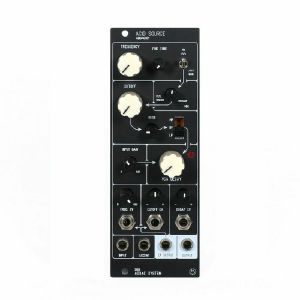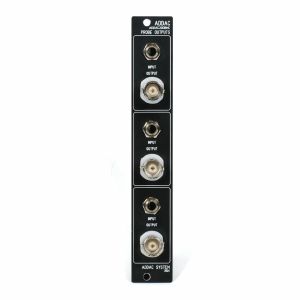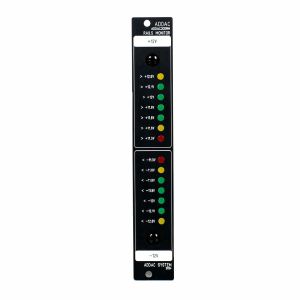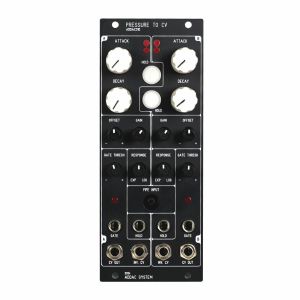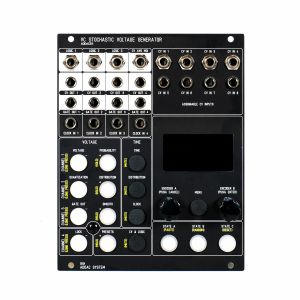Receive new release alerts for ADDAC System
Filter
Equipment
Format
Featured
Price
Tags
Items 1 to 8 of 8 on page 1 of 1
ADDAC System ADDAC107 Acid Source Synth Voice Module (B-STOCK) (synth voice synth module)
Cat: 1084407 Rel: 01 Jan 90
B-STOCK: Product with some signs of usage but in perfect working order
Notes: ***B-STOCK: Product with some signs of usage but in perfect working order***
A fresh twist on a simple 303-style acid synth, featuring a triangle/sawtooth/square wave VCO, multi-mode resonant filter, simple AD envelope and a VCA which can be overdriven. Excellent value.
Supplier's Notes:
ADDAC started this module with the idea of developing a complex drum source however, somewhere along the process, it was clear how much better it performed as a synth voice and this lucky accident was embraced.
It features a VCO with a [FREQUENCY] and [FINE TUNE] knob plus a dedicated CV Input and Attenuator knob (tunable over 4 octaves).
The VCO waveform output is achieved by selecting either a Triangle or Saw through a switch. the selected waveform can then be mixed/balanced against the square wave. The resulting mix is then sent to the Filter.
The Filter features a [CUTOFF] and [RESO] resonance knob plus a Cutoff CV Input and Attenuverter knob.
A 3 position switch is used to select the filter type: Highpass, Bandpass or Lowpass.
The resulting output is then sent to the VCA.
The VCA features an Input with [INPUT GAIN] knob which at maximum can amplify the incoming signal by a factor of 2.
This is a very important control, it accepts any signal Trigger, Gate or CV. Whatever input is plugged in the signal is then fed through an AD with a very short attack and controllable decay through the [VCA DECAY] knob plus the CV Input and Attenuverter knob. The resulting slewed signal is then used to control the VCA gain.
This signal is also sent to the CV OUTPUT as well as the LED monitor.
The Accent input adds to the Input signal creating a different amplitude output.
The CV OUTPUT is normalled to the Frequency and Cutoff inputs.
Tech Specs:
9HP
4cm deep
80mA +12V
80mA -12V
The [INPUT GAIN] knob
Usually Attack/Decay envelopes have a maximum voltage of +5v, no matter if the input gate is +5v or above the AD will clip at +5v. In this case, this clipping method was not used, and instead ADDAC allowed the incoming voltage to determine the maximum AD voltage, meaning that if a +5v gate is present then the AD maximum voltage will be +5v but if a gate of +10v is sent then the AD maximum voltage will be +10v.
This also means that with higher input voltages the decay, although falling at the same speed, will be longer than with lower voltages as it has a longer range to go back to 0v.
As previously mentioned, The [INPUT GAIN] knob can amplify the incoming input by a factor of 2, allowing to use a standard +5v gate or envelope and being able to make the resultant AD go up to +10v.
The AD signal is responsible for opening the VCA. Up to +5v the VCA will open to unity gain above this value the VCA will start to amplify and eventually saturate and distort. This saturation will add harmonics to the signal which will change its gentle timbrical nature to a more unique and peculiar timbre that will make the module shine in Acid contexts.
Adding high levels of Resonance or even filter self oscillation in combination with high VCA saturation will create even more harmonics that ADDAC highly encourage the user to explore.
… Read moreA fresh twist on a simple 303-style acid synth, featuring a triangle/sawtooth/square wave VCO, multi-mode resonant filter, simple AD envelope and a VCA which can be overdriven. Excellent value.
Supplier's Notes:
ADDAC started this module with the idea of developing a complex drum source however, somewhere along the process, it was clear how much better it performed as a synth voice and this lucky accident was embraced.
It features a VCO with a [FREQUENCY] and [FINE TUNE] knob plus a dedicated CV Input and Attenuator knob (tunable over 4 octaves).
The VCO waveform output is achieved by selecting either a Triangle or Saw through a switch. the selected waveform can then be mixed/balanced against the square wave. The resulting mix is then sent to the Filter.
The Filter features a [CUTOFF] and [RESO] resonance knob plus a Cutoff CV Input and Attenuverter knob.
A 3 position switch is used to select the filter type: Highpass, Bandpass or Lowpass.
The resulting output is then sent to the VCA.
The VCA features an Input with [INPUT GAIN] knob which at maximum can amplify the incoming signal by a factor of 2.
This is a very important control, it accepts any signal Trigger, Gate or CV. Whatever input is plugged in the signal is then fed through an AD with a very short attack and controllable decay through the [VCA DECAY] knob plus the CV Input and Attenuverter knob. The resulting slewed signal is then used to control the VCA gain.
This signal is also sent to the CV OUTPUT as well as the LED monitor.
The Accent input adds to the Input signal creating a different amplitude output.
The CV OUTPUT is normalled to the Frequency and Cutoff inputs.
Tech Specs:
9HP
4cm deep
80mA +12V
80mA -12V
The [INPUT GAIN] knob
Usually Attack/Decay envelopes have a maximum voltage of +5v, no matter if the input gate is +5v or above the AD will clip at +5v. In this case, this clipping method was not used, and instead ADDAC allowed the incoming voltage to determine the maximum AD voltage, meaning that if a +5v gate is present then the AD maximum voltage will be +5v but if a gate of +10v is sent then the AD maximum voltage will be +10v.
This also means that with higher input voltages the decay, although falling at the same speed, will be longer than with lower voltages as it has a longer range to go back to 0v.
As previously mentioned, The [INPUT GAIN] knob can amplify the incoming input by a factor of 2, allowing to use a standard +5v gate or envelope and being able to make the resultant AD go up to +10v.
The AD signal is responsible for opening the VCA. Up to +5v the VCA will open to unity gain above this value the VCA will start to amplify and eventually saturate and distort. This saturation will add harmonics to the signal which will change its gentle timbrical nature to a more unique and peculiar timbre that will make the module shine in Acid contexts.
Adding high levels of Resonance or even filter self oscillation in combination with high VCA saturation will create even more harmonics that ADDAC highly encourage the user to explore.
1 in stock $207.30
ADDAC System ADDAC200BNC Probe Outputs Module (modular synthesiser)
Cat: 1031331 Rel: 13 Sep 24
Probe outputs module - 4HP
Notes: A passive module to allow easy connection from Modular to Eurorack, avoid flimsy hook probes or alligator wires with a robust connection that will keep your signal intact.
Features:
3.5mm jack to BNC including 50O male-male cables.
Ships calibrated set to 10x as default, user's can select 1x but soldering a smd jumper.
Specs:
4HP
15mm deep
Passive
… Read moreFeatures:
3.5mm jack to BNC including 50O male-male cables.
Ships calibrated set to 10x as default, user's can select 1x but soldering a smd jumper.
Specs:
4HP
15mm deep
Passive
3 in stock $107.53
Click for better price!
or call +44 20 7424 1960
quote 1031331
quote 1031331
ADDAC System ADDAC200RM Rails Monitor Module (modular synthesiser)
Cat: 1028712 Rel: 13 Sep 24
LED voltage meter module - 4HP
Notes: ADDAC200RM allows a simple and straight forward way to monitor the voltage of your system. A 0.1% precision analogue voltage meter shows the status of both +12V and -12V rail.
Eurorack +/-12V power rails
Although we all refer to Eurorack PSU voltages as +12V and -12V this is hardly ever the case, although most systems operate at close proximity to this ideal reference, there are situations where the drop from the ideal voltage is large enough to influence the performance of your system.
PSU current ratings
Running a PSU too close to its limits will always cause more stress to the PSU, a good practice it to use only about 75% of your PSU maximum ratings, this will greatly extend the PSU life.
PSUs will show a small voltage drop as current increases which will drastically increase when pushed closed to it's limits. Heat will also influence this drop, heat is related to the current drawn, as more current is being drawn more heat will build up on the PSU, heat conditions will reduce the maxi- mum amount of current that can be delivered by the PSU. While the current consumption drop is somewhat stable and immediate (as you turn the frame on the current consumption will stabilize in a few seconds) the heat drop will take some time to occur, heat will build up over time until it stabilizes and only if it has "headroom" to stabilize. If heat dissipation is not effective than the drop will continue until it reaches a balance point which can be several volts below the 12V reference. At this point your PSU will be under great stress and the heat generated is prone to leave some permanent scars.
Heat will start to have an impact at about an ambient temperature of 50 degrees celsius, at 70 degrees the maxi- mum current rating will drop by 50%. If your PSU is rated at 2A maximum and it's running at 70 degrees then it will only be able to deliver 1A maximum.
For the PSU this is a complex balancing act as current influences heat and heat influences the maximum amount of current available which all together influences the voltage drop.
This is why it's so important to keep the PSU load at a sensible level.
PSU protections
Some PSUs feature over voltage, over current and overheating protection and will turn off when the operating conditions trigger any of the protection threshold levels.
At this point it's typical that the PSU will enter a Hiccup mode, where it turns on checks the current conditions and quickly turns off if they haven't changed, leaving it in an intermittent limbo where it powers on and off at some regular frequency.
If the conditions change enough to drop below the protection threshold levels then the PSU will automatically recover and stay on.
PSU stress
Different situations can be responsible for causing stress that can damage the PSU, it's possible to reverse a ribbon power cable enough times or leaving it connected long enough to partly damage the PSU.
Another situation is having a module that due to some partial previous damage may be drawing more current than specified which will not be accounted for when calculating your system current consumption.
Stress can cause permanent damage to the PSU, however some damages can be only partial leaving you with a PSU that no longer features the specs described by the manufacturer but with no apparent misbehaviour. The LED monitors on bus boards will be on, but in reality it will be underperforming at an unknown percentage of the original specs. These situations can be quite hard to debug without the proper tools to evaluate the cause of the problem.
PSU impact on modules
Some modules are more susceptible to PSU changes than others, modules that feature internal regulators will be less susceptible to PSU voltage, modules that use internal +5v, +/-9v, +/-10v regulators will have more tolerance than modules that use the PSU voltages directly like it is for most cases. Also modules that use voltage reverse protection will already have a 0.3v to 0.8v drop inherent to the protection circuit.
While many digital modules can withstand lower voltages some others will be more dependent on the reference voltage and may show strange behaviours.
This module can help preventing all these situations, it won't fix any problem but can help on the day-to-day monitoring of your system and in keeping your PSU in healthy conditions.
Tech Specs: 4HP/3,5 cm deep
60mA +12V
60mA -12V
… Read moreEurorack +/-12V power rails
Although we all refer to Eurorack PSU voltages as +12V and -12V this is hardly ever the case, although most systems operate at close proximity to this ideal reference, there are situations where the drop from the ideal voltage is large enough to influence the performance of your system.
PSU current ratings
Running a PSU too close to its limits will always cause more stress to the PSU, a good practice it to use only about 75% of your PSU maximum ratings, this will greatly extend the PSU life.
PSUs will show a small voltage drop as current increases which will drastically increase when pushed closed to it's limits. Heat will also influence this drop, heat is related to the current drawn, as more current is being drawn more heat will build up on the PSU, heat conditions will reduce the maxi- mum amount of current that can be delivered by the PSU. While the current consumption drop is somewhat stable and immediate (as you turn the frame on the current consumption will stabilize in a few seconds) the heat drop will take some time to occur, heat will build up over time until it stabilizes and only if it has "headroom" to stabilize. If heat dissipation is not effective than the drop will continue until it reaches a balance point which can be several volts below the 12V reference. At this point your PSU will be under great stress and the heat generated is prone to leave some permanent scars.
Heat will start to have an impact at about an ambient temperature of 50 degrees celsius, at 70 degrees the maxi- mum current rating will drop by 50%. If your PSU is rated at 2A maximum and it's running at 70 degrees then it will only be able to deliver 1A maximum.
For the PSU this is a complex balancing act as current influences heat and heat influences the maximum amount of current available which all together influences the voltage drop.
This is why it's so important to keep the PSU load at a sensible level.
PSU protections
Some PSUs feature over voltage, over current and overheating protection and will turn off when the operating conditions trigger any of the protection threshold levels.
At this point it's typical that the PSU will enter a Hiccup mode, where it turns on checks the current conditions and quickly turns off if they haven't changed, leaving it in an intermittent limbo where it powers on and off at some regular frequency.
If the conditions change enough to drop below the protection threshold levels then the PSU will automatically recover and stay on.
PSU stress
Different situations can be responsible for causing stress that can damage the PSU, it's possible to reverse a ribbon power cable enough times or leaving it connected long enough to partly damage the PSU.
Another situation is having a module that due to some partial previous damage may be drawing more current than specified which will not be accounted for when calculating your system current consumption.
Stress can cause permanent damage to the PSU, however some damages can be only partial leaving you with a PSU that no longer features the specs described by the manufacturer but with no apparent misbehaviour. The LED monitors on bus boards will be on, but in reality it will be underperforming at an unknown percentage of the original specs. These situations can be quite hard to debug without the proper tools to evaluate the cause of the problem.
PSU impact on modules
Some modules are more susceptible to PSU changes than others, modules that feature internal regulators will be less susceptible to PSU voltage, modules that use internal +5v, +/-9v, +/-10v regulators will have more tolerance than modules that use the PSU voltages directly like it is for most cases. Also modules that use voltage reverse protection will already have a 0.3v to 0.8v drop inherent to the protection circuit.
While many digital modules can withstand lower voltages some others will be more dependent on the reference voltage and may show strange behaviours.
This module can help preventing all these situations, it won't fix any problem but can help on the day-to-day monitoring of your system and in keeping your PSU in healthy conditions.
Tech Specs: 4HP/3,5 cm deep
60mA +12V
60mA -12V
1 in stock $119.71
Click for better price!
or call +44 20 7424 1960
quote 1028712
quote 1028712
ADDAC System ADDAC219IN Stereo To Dual Mono In Module (preamp synth module)
Cat: 1052227 Rel: 12 Dec 24
Analogue CV utilities module - 3hp
Notes: ADDAC219IN was designed to replace bulky 1/4 inch jacks when plugging external stereo gear into the modular realm.
Using a 3.5mm TRS stereo jack input, the module splits the TRS stereo signal into 2 mono outputs (Left + Right) while also converting the line input to synth level.
There are 2 independent sections allowing for two stereo sources to be connected.
Tech Specs: 3HP, 4 cm deep, 20mA +12V, 20mA -12V
… Read moreUsing a 3.5mm TRS stereo jack input, the module splits the TRS stereo signal into 2 mono outputs (Left + Right) while also converting the line input to synth level.
There are 2 independent sections allowing for two stereo sources to be connected.
Tech Specs: 3HP, 4 cm deep, 20mA +12V, 20mA -12V
2 in stock $81.20
Click for better price!
or call +44 20 7424 1960
quote 1052227
quote 1052227
ADDAC System ADDAC219OUT Dual Mono To Stereo Out Module (modular synthesiser)
Cat: 1052230 Rel: 12 Dec 24
Analogue CV utilities module - 3hp
Notes: ADDAC219OUT was designed to replace bulky 1/4-inch cables when plugging external stereo gear to the modular realm.
It merges 2 TS mono signals (Left + Right) into a TRS stereo output while also converts the synth inputs to line level.
There are 3 independent sections allowing for three stereo sources to be connected.
Tech Specs: 3HP, 1.5 cm deep, Passive module
… Read moreIt merges 2 TS mono signals (Left + Right) into a TRS stereo output while also converts the synth inputs to line level.
There are 3 independent sections allowing for three stereo sources to be connected.
Tech Specs: 3HP, 1.5 cm deep, Passive module
3 in stock $94.50
Click for better price!
or call +44 20 7424 1960
quote 1052230
quote 1052230
ADDAC System ADDAC310 Pressure To CV Module (modular synthesiser)
Cat: 1034160 Rel: 13 Sep 24
Pressure to CV module - 10HP
Notes: Control Eurorack using your breath with this unique module from ADDAC. A melodica pipe connected to the front panel allows you to generate two independent CV signals from breath inputs. Funky.
Supplier's Notes:
This module expands ADDAC's line of expressive controls, it follows the heritage of wind/breath controllers with one major difference, the pipe has no air escape creating pressure inside the tube controlled by the user's mouth. For a seasoned woodwind or brass musicians this working principle may sound unorthodox, however this way pressure can be controlled for longer without the need to breath in or learning circular breathing techniques. It's relatively easy to control the pressure in your mouth while still breathing through the nose.
The module is provided with a standard melodica pipe which connects to an air filter (providing a receptacle for condensation to form and isolate the sensor) and lastly connects to the module frontpanel.
The signal captured by the sensor is then sent to two independent sections with exactly the same functions as seen in the signal flow diagram below.
As an example the two sections can be used with different settings to independently control the VCA and VCF of any standard analogue voice patch.
Pipe
ADDAC are using a standard Melodica pipe into an air filter that will keep condensation away from the sensor. The air filter is then connected to the frontpanel sensor input using a silicone tube.
Sensor calibration
[RESPONSE] is the main control to calibrate the pressure curve, the knob goes from exponential to logarithmic with linear at 12 o'clock. Exponential will be more reactive to high pressures, logarithmic to lower pressures.
Hold function
This feature allows to hold the current voltage value with the hold is engaged (button led on), the state can be changed either by the push button in a latching manner (push to change state) or via the gate input in a momentary manner (hold on while gate is on)
Extra Pipe
Extra Pipes are available separately.
Tech Specs:
10HP
4.5cm deep
70mA +12V
40mA -12V
… Read moreSupplier's Notes:
This module expands ADDAC's line of expressive controls, it follows the heritage of wind/breath controllers with one major difference, the pipe has no air escape creating pressure inside the tube controlled by the user's mouth. For a seasoned woodwind or brass musicians this working principle may sound unorthodox, however this way pressure can be controlled for longer without the need to breath in or learning circular breathing techniques. It's relatively easy to control the pressure in your mouth while still breathing through the nose.
The module is provided with a standard melodica pipe which connects to an air filter (providing a receptacle for condensation to form and isolate the sensor) and lastly connects to the module frontpanel.
The signal captured by the sensor is then sent to two independent sections with exactly the same functions as seen in the signal flow diagram below.
As an example the two sections can be used with different settings to independently control the VCA and VCF of any standard analogue voice patch.
Pipe
ADDAC are using a standard Melodica pipe into an air filter that will keep condensation away from the sensor. The air filter is then connected to the frontpanel sensor input using a silicone tube.
Sensor calibration
[RESPONSE] is the main control to calibrate the pressure curve, the knob goes from exponential to logarithmic with linear at 12 o'clock. Exponential will be more reactive to high pressures, logarithmic to lower pressures.
Hold function
This feature allows to hold the current voltage value with the hold is engaged (button led on), the state can be changed either by the push button in a latching manner (push to change state) or via the gate input in a momentary manner (hold on while gate is on)
Extra Pipe
Extra Pipes are available separately.
Tech Specs:
10HP
4.5cm deep
70mA +12V
40mA -12V
3 in stock $374.69
Click for better price!
or call +44 20 7424 1960
quote 1034160
quote 1034160
ADDAC System ADDAC511 VC Stochastic Voltage Generator Module (voltage generator synth module)
Cat: 1080319 Rel: 08 May 25
This is a fully fledged 4 channel voltage generator capable of all things random, with quantization, probability, distribution, interpolation, time control, clock, states and a 32 step sequencer
Notes: Based on the ADDAC501 Complex Random module, the 511 expands the concept to become an even more powerful random/stochastic voltage generator. Four channels, all capable of being used for envelopes, modulation sources, sequencers and much more.
Supplier's Notes:
This module greatly expands on the principles of the ADDAC501 Complex Random from 2013.
This is a fully fledged 4 channel voltage generator capable of all things random, with quantization, probability, distribution, interpolation, time control, clock, states and a 32 step sequencer.
The module operation relies on its screen for all parameter editing, each button accesses one single page where parameters can be changed allowing a fast and fluid workflow across all settings.
Long presses on all buttons have a secondary function allowing fast Channel selection plus Mute and Hold functions.
The combination of having 2 Encoders with Push buttons allow swift navigation and editing across all pages and their settings.
Tech Specs:
20HP
4.5cm deep
200mA +12V
100mA -12V
… Read moreSupplier's Notes:
This module greatly expands on the principles of the ADDAC501 Complex Random from 2013.
This is a fully fledged 4 channel voltage generator capable of all things random, with quantization, probability, distribution, interpolation, time control, clock, states and a 32 step sequencer.
The module operation relies on its screen for all parameter editing, each button accesses one single page where parameters can be changed allowing a fast and fluid workflow across all settings.
Long presses on all buttons have a secondary function allowing fast Channel selection plus Mute and Hold functions.
The combination of having 2 Encoders with Push buttons allow swift navigation and editing across all pages and their settings.
Tech Specs:
20HP
4.5cm deep
200mA +12V
100mA -12V
2 in stock $624.12
Click for better price!
or call +44 20 7424 1960
quote 1080319
quote 1080319
ADDAC System ADDAC814 6x6 Stereo Matrix Mixer Module (mixer synth module)
Cat: 1054403 Rel: 12 Dec 24
6x6 stereo matrix mixer module - 25HP + 8HP (33HP total)
Notes: A typically well thought-out approach to matrix mixing from ADDAC, the 814 is a stereo, expandable 6x6 design with separate control and in/out modules. Suitable for line/synth level audio or CV.
Supplier's Notes:
Introducing ADDAC's take on matrix mixers, a 6x6 stereo matrix easily expandable to larger configurations.
Matrix mixers may need some time to get used to, but they are very much self-explanatory, each knob controls the volume of a matrix point routing the respective input to the desired output. The flexibility of a matrix mixer is far superior to a standard mixer, the possibility to route any input to any single or multiple outputs allow for very complex chains, combining parallel and series processing while easily reconfigurable without any extra patching.
All Inputs Left channels are normalled to the Right Inputs.
Blank areas on the left and bottom edges of the panel allow for the user to write all the inputs and outputs sources that each channel is connected to.
Different coloured knobs for faster visual recalling: Black for A,C,E Outputs Dark Red for B,D,F Outputs Cream knobs for potential feedback diagonal: 1A, 2B, 3C, 4D, 5E, 6F.
DC coupled circuitry, can be used to mix both audio or cv signals.
Jumpers on the back of both modules allow the user to set each channel independently to Line or Synth Level, making it easier to integrate with external sources, sound processors or guitar pedals.
Internal connections
The control and input modules are connected via a large 34 wire ribbon cable, only the control module needs to be connected to the Busboard.
Extra IDC sockets are used for connecting larger configurations like 12x12 or 18x18.
Other configurations are also possible: 6x12, 12x6, 12x12, etc...
Up to 12x12 all ribbon cables are provided, for larger matrixes custom ones will be necessary, contact us directly if planning to go BIG.
Potentiometers
Although ADDAC System are using Thonk's Tall Trimmer Topper for Knobs all potentiometers used have metal shaft and are not plastic trimmer potentiometers.
Tech Specs: 25HP + 8HP (33HP total, 4.5cm deep, 140mA +12V, 140mA -12V
… Read moreSupplier's Notes:
Introducing ADDAC's take on matrix mixers, a 6x6 stereo matrix easily expandable to larger configurations.
Matrix mixers may need some time to get used to, but they are very much self-explanatory, each knob controls the volume of a matrix point routing the respective input to the desired output. The flexibility of a matrix mixer is far superior to a standard mixer, the possibility to route any input to any single or multiple outputs allow for very complex chains, combining parallel and series processing while easily reconfigurable without any extra patching.
All Inputs Left channels are normalled to the Right Inputs.
Blank areas on the left and bottom edges of the panel allow for the user to write all the inputs and outputs sources that each channel is connected to.
Different coloured knobs for faster visual recalling: Black for A,C,E Outputs Dark Red for B,D,F Outputs Cream knobs for potential feedback diagonal: 1A, 2B, 3C, 4D, 5E, 6F.
DC coupled circuitry, can be used to mix both audio or cv signals.
Jumpers on the back of both modules allow the user to set each channel independently to Line or Synth Level, making it easier to integrate with external sources, sound processors or guitar pedals.
Internal connections
The control and input modules are connected via a large 34 wire ribbon cable, only the control module needs to be connected to the Busboard.
Extra IDC sockets are used for connecting larger configurations like 12x12 or 18x18.
Other configurations are also possible: 6x12, 12x6, 12x12, etc...
Up to 12x12 all ribbon cables are provided, for larger matrixes custom ones will be necessary, contact us directly if planning to go BIG.
Potentiometers
Although ADDAC System are using Thonk's Tall Trimmer Topper for Knobs all potentiometers used have metal shaft and are not plastic trimmer potentiometers.
Tech Specs: 25HP + 8HP (33HP total, 4.5cm deep, 140mA +12V, 140mA -12V
4 in stock $368.04
Items 1 to 8 of 8 on page 1 of 1

 USD
USD





